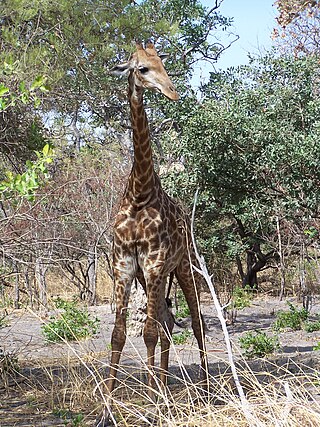
The Araliaceae are a family of flowering plants composed of about 43 genera and around 1500 species consisting of primarily woody plants and some herbaceous plants. The morphology of Araliaceae varies widely, but it is predominantly distinguishable based on its woody habit, tropical distribution, and the presence of simple umbels.

Ticodendron incognitum is the only species of Ticodendron, and the only member of the family Ticodendraceae. It is most closely related to the family Betulaceae.

Translocation in wildlife conservation is the capture, transport and release or introduction of species, habitats or other ecological material from one location to another. It contrasts with reintroduction, a term which is generally used to denote the introduction into the wild of species from captive stock. The International Union for the Conservation of Nature (IUCN) catalogues translocation projects for threatened species around the globe.
This article is a list of biological species, subspecies, and evolutionary significant units that are known to have become extinct during the Holocene, the current geologic epoch, ordered by their known or approximate date of disappearance from oldest to most recent.
Ammopelmatus kelsoensis, commonly known as the Kelso Jerusalem cricket, is a species of insect in the family Stenopelmatidae. It is endemic to the Kelso Dunes in the United States. Despite intensive collecting, all specimens have only been found at Point Conception.

Ammopelmatus is a genus of insects in the family Stenopelmatidae, one of two genera of large, flightless insects referred to commonly as Jerusalem crickets. They are native to western United States and northwestern Mexico.
Ammopelmatus cahuilaensis is a species of insect in the family Stenopelmatidae. The species is found in the Coachella Valley and was described by Ernest R. Tinkham in 1968, in The Great Basin Naturalist.
Ammopelmatus navajo, commonly known as the Navajo Jerusalem cricket, is a species of nocturnal Jerusalem cricket in the family Stenopelmatidae. It is endemic to the United States, specifically Arizona, and found under rocks in loose soil. It is closely related to A. fuscus and they have nearly identical drumming patterns. They live one to two years as adults, but can die prematurely by parasitic infections, commonly by the horsehair worm.
Ammopelmatus nigrocapitatus is a species of insect in the family Stenopelmatidae. It is endemic to parts of Southern California.

Jerusalem crickets are a group of large, flightless insects in the genera Ammopelmatus and Stenopelmatus, together comprising the tribe Stenopelmatini. The former genus is native to the western United States and parts of Mexico, while the latter genus is from Central America.
Ammopelmatus pictus is a species of Jerusalem cricket in the family Stenopelmatidae. It is found in parts of the Central Valley, Diablo Range, and Silicon Valley within California.
Ammopelmatus mescaleroensis is a species of Jerusalem cricket in the family Stenopelmatidae. It is found in the area around Mescalero, in the United States state of New Mexico.
Ammopelmatus longispina is a species of Jerusalem cricket in the family Stenopelmatidae. It is found in North America.






